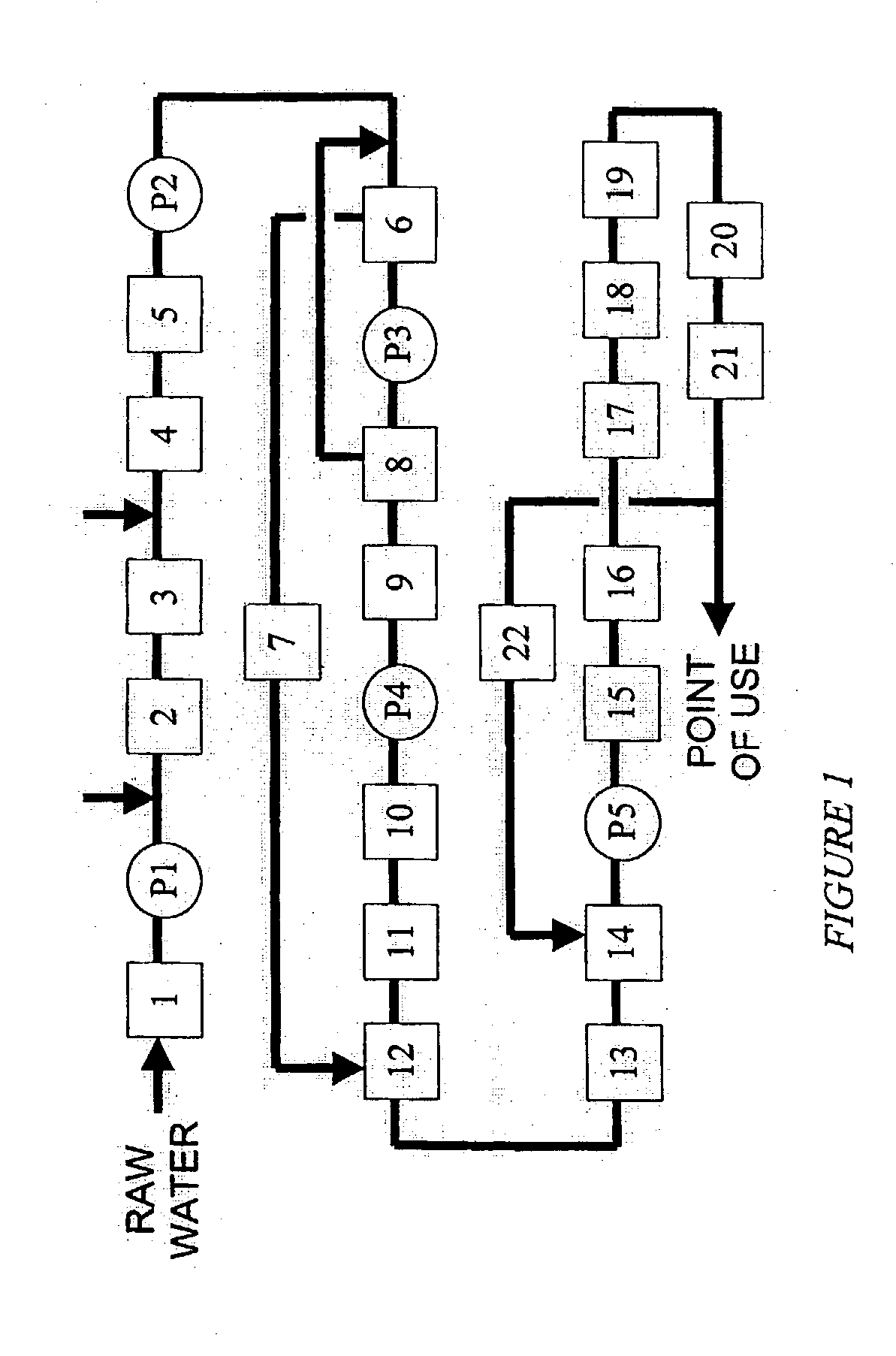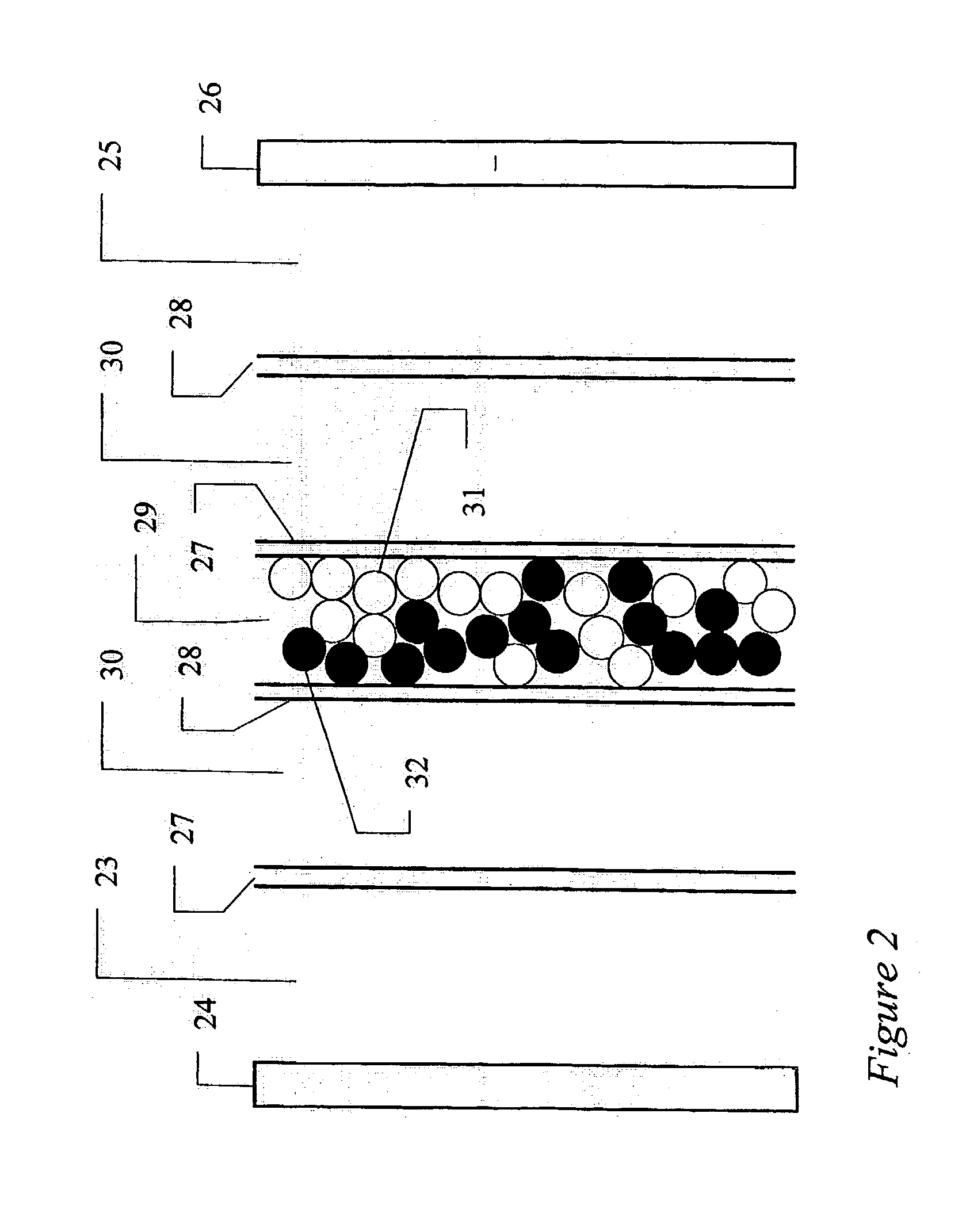Apparatus and method for continuous electrodeionization
- Summary
- Abstract
- Description
- Claims
- Application Information
AI Technical Summary
Benefits of technology
Problems solved by technology
Method used
Image
Examples
example 1
[0069] A standard reverse flow softener was used to remove the hardness elements from the first pass reverse osmosis reject stream. The ion exchange resin was of a sulphonic acid type cation exchange resin (trade name: Amberjet 1200 Na manufactured by Rohm and Haas). A 250 mm external diameter reverse flow softener was used in the present experimental study for a maximum water flowrate of 7.0 gpm and a cycle time of 8.0 hours. The resin volume was 50 liters. Space velocity through the vessel was 32.4 BV / h at 7.0-gpm flowrate. Regeneration was conducted with 10% brine solution at a level of 150 grams per liter of resin. This standard reverse flow softener achieved an outlet hardness of about 1.5 ppm as calcium carbonate. The conductivity of the softened water was in the range of 1300-1600 microsiemens / cm. This conductivity of the softened water was about 3 times that of the source water supply because the reverse osmosis system was operating at an overall recovery ratio of 66.5%. A p...
example 2
[0072] A comparative experiment was conducted with the use of above standard reverse flow softener with the exception of operating the electrodeionization apparatus at a recovery of 95%. This standard reverse flow softener achieved an outlet hardness of about 1.5 ppm as calcium carbonate. The conductivity of the softened water was in the range of 1300-1600 microsiemens / cm. This conductivity of the softened water was about 3 times that of the source water supply because the reverse osmosis system was operating at an overall recovery ratio of 66.5%. A pressure reducing valve (PRV) Type V 82 (manufactured by George Fischer) was used in the outlet stream from the standard reverse flow softener to ensure that the concentrate and electrode feed stream is introduced at a pressure of 5 to 10 psig below that of the inlet stream of the purifying compartments in the electrodeionization apparatus. Any suitable pressure reducing valve may be used. The injection of Pretreat Plus.TM. 0100 antiscal...
example 3
[0073] A weak acid cation resin in the sodium form was used to remove the hardness elements from the first pass reverse osmosis reject stream. Sodium hydroxide was added to the feed stream so that alkalinity exceeded the total hardness. The ion exchange resin was of a carboxylic acid type cation exchange resin (trade name: Amberlite IRC 86 manufactured by Rohm and Haas). A 300 mm external diameter weak acid cation exchanger was used in the present experimental study for a maximum water flowrate of 8.0 gpm and a cycle time of 20.0 hours. The resin volume was 75 liters. Space velocity through the vessel was 24.0 BV / h at 8.0-gpm flowrate. Regeneration was conducted with 5% hydrochloric acid at a level of 78 grams per liter of resin, which is equivalent to 110% regeneration ratio. Subsequently, sodium hydroxide conditioning was performed to convert the regenerated resin to the sodium form. This sodium conversion was performed in the upflow manner to avoid bed compression. Because resin ...
PUM
| Property | Measurement | Unit |
|---|---|---|
| Fraction | aaaaa | aaaaa |
| Fraction | aaaaa | aaaaa |
| Fraction | aaaaa | aaaaa |
Abstract
Description
Claims
Application Information
 Login to View More
Login to View More - R&D
- Intellectual Property
- Life Sciences
- Materials
- Tech Scout
- Unparalleled Data Quality
- Higher Quality Content
- 60% Fewer Hallucinations
Browse by: Latest US Patents, China's latest patents, Technical Efficacy Thesaurus, Application Domain, Technology Topic, Popular Technical Reports.
© 2025 PatSnap. All rights reserved.Legal|Privacy policy|Modern Slavery Act Transparency Statement|Sitemap|About US| Contact US: help@patsnap.com



